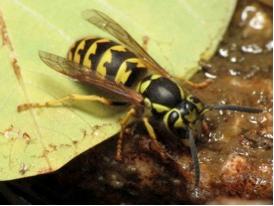Yellowjackets
-
AboutYellowjackets are one-half to one inch long with jagged bright yellow and black stripes. Their narrow “waists” are barely visible. Unlike other common wasps, yellowjackets scavenge on food. They nest in holes in the ground, inside wall cavities, or in hanging nests totally enclosed in gray paper with a single entrance. Yellowjackets defend their nests, as do other social wasps and bees, but are more likely to sting if disturbed while foraging. Stings generally cause pain and short-term injury, but some people suffer severe allergic responses.
 Photo: Wikimedia Commons
Photo: Wikimedia Commons -
CategoryInsect
-
Signs/Symptoms
Concern about yellowjackets is based on their persistent, aggressive behavior around food sources and their confrontational defense of their nest and colony. Usually stinging behavior is encountered at nesting sites, but sometimes scavenging yellowjackets will sting when you swat them away from a potential food source.
-
Where
Usually stinging behavior is encountered from yellowjackets near their nesting sites and around food sources at picnics, other outdoor meals, garbage cans, dishes of dog or cat food placed outside.
They build nests in rodent burrows, or other protected cavities, such as voids in walls and ceilings of houses, as nesting sites.
Be on the lookout for nests when outdoors. Yellowjackets that are flying directly in and out of a single location are probably flying to and from their nest.
-
When
Yellowjackets start to show up during the late summer and fall.
Yellowjackets are active during the day and are most likely to be in their nest at night.
-
Prevent
Stay calm to avoid stings:
If a wasp lands on you, don’t swat it or run. Wait for it to leave, or gently brush it away.
Don’t disturb nests. Yellowjackets flying from a hole in the ground or a building indicate a probable nest.
Remove attractive food sources:
Keep food, including pet food, covered or indoors.
Outdoors, cover soda cans so yellowjackets don’t crawl in.
Keep garbage in sealed cans and empty regularly.
Pick up and dispose of ripe fruit.
-
Manage
Removing nest:
The easiest and safest way to get rid of a wasp nest is to call for professional help. If a rapid solution to a severe yellowjacket problem is essential, seek the assistance of a professional pest control operator or consider installing bait stations.
The Marin/Sonoma Mosquito & Vector Control District will eliminate in-ground yellowjacket nests free of charge for residents of Marin and Sonoma counties (if the location of the nest is known and marked). Locating a nest is not easy, as yellowjackets will forage in an area about one-quarter mile in diameter. You may be able to locate the nest by following wasps back to the entrance. For more information go to: Marin and Sonoma Mosquito & Vector Control District yellowjacket control program
Use traps to reduce yellowjacket numbers
Yellow lure traps hung along the perimeter of a property can reduce some species around patios or picnic areas. Lure traps are available for purchase at many retail stores that sell pest control supplies. Lure traps can help reduce the number of localized foraging workers, but they don’t eliminate large populations. Lure traps contain a chemical that attracts yellowjackets into the traps, but the common lure in traps, heptyl butyrate, attracts primarily the western yellowjacket and not other species. Meat such as chicken can be added as an attractant and is believed to improve catches of the German yellowjacket and V. vulgaris. Replace meat frequently, because yellowjackets aren’t attracted to rotting meat. Also, periodically check the trap to remove trapped yellowjackets and make sure workers are still attracted to the trap. Lures need to be replaced periodically; follow trap directions regarding replacement.
-
More Information
Although many animals prey on social wasps—including birds, reptiles, amphibians, skunks, bears, raccoons, spiders, praying mantis, and bald-faced hornets—none provides satisfactory biological control in home situations.

